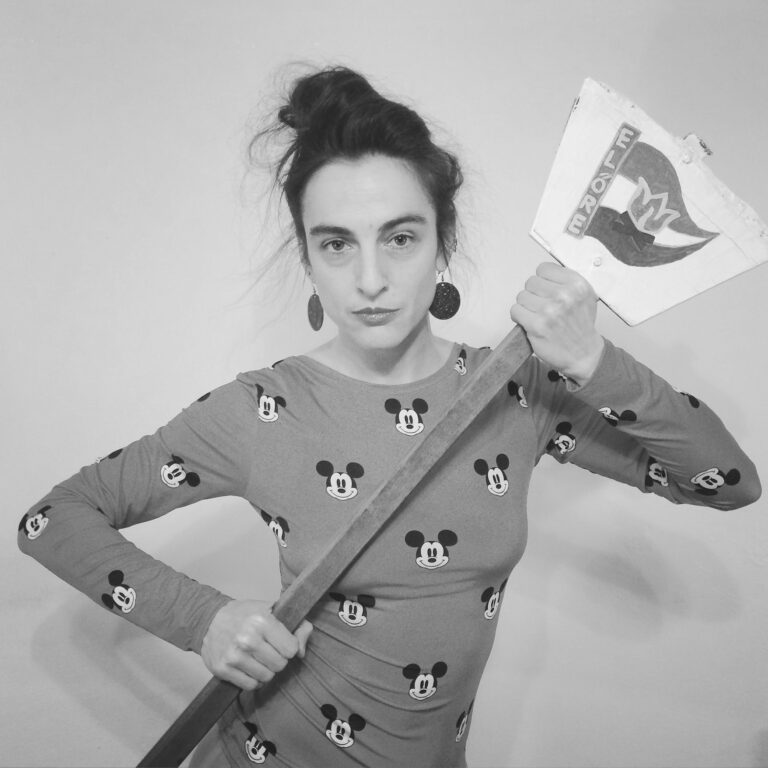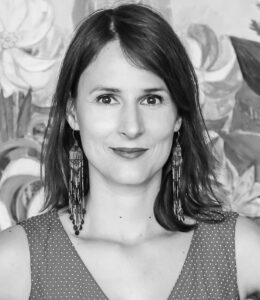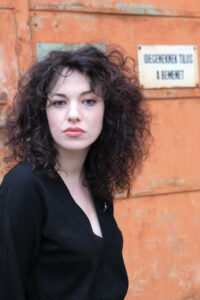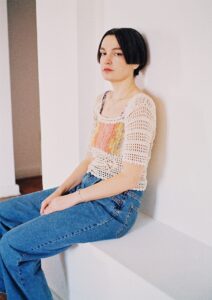Ágnes Éva Molnár

– born 1980. She is a Hungarian media artist working in the genres of photography, video and performance art. In the centre of her artistic interest lie themes such as gender inequality, violation of human rights and power relations in society. In her series, she is often overwriting the position of the photographer by photographing herself. Her set scenes, imbued with contingencies, tensely reflect on psychological problems. She has been teaching media art as an adjunct assistant professor since 2016 at the Rippl-Rónai Faculty of Arts of the Kaposvár University, Hungary.
Art is for me a way to express my thoughts, a language I speak. Being an artist is not an occupation for me, rather a creative activity, a part of me, an obsession. With my works I want to have an impact on the viewers by drawing their attention to issues that are not visible or apparent in our daily lives. It concerns mainly gender roles, sexuality, human injustices.
When I would like to define the role of an artist, I find important to distinguish art “forms” by their goals. Some artworks do not intend to convey a message or a thought, they are made by pure aesthetics, to please the eye. They absolutely have their place and function in the world. But I rather “believe” in artworks that make the viewer think or change their opinion, that do not (solely) entertain, but function as a trigger for change. Therefore, I consider that our social role as an artist – or at least I feel obliged to create my works accordingly – is to be sensitive, keep our eyes open, then make the results of our observations visible: shed light on issues or sensitive matters that are hidden for the majority. I imagine artists being barometers of society.
I draw inspiration from news, reports, events around the world that capture my attention by reporting human – especially gender – Inequalities. In some cases, I use direct reference to the given event, in other cases these news and reports serve as a trigger. My work Hundred Times falls into the first category. The images reflect to actual events, the phrases written on human bodies are provocative sentences: these are promises of an imaginary obedient citizen for not committing again the given sin. These promises written down – even if not literally hundred, but many – times refer to the punishment used in schools against children12345678910.
Feminism has always been in the centre of both my personal and artistic interest. There are many achievements that we take for granted today can be attributed to feminism, feminist movements and brave women (men too). Women have the right to learn, to choose any career, to earn money, to have their own budget, they are freed from arranged marriage and have the right to inherit, just to name a few. Despite these highly significant results, patriarchy and sexism are still present all around the world.
I started to deal with photographic self-portrait and to create female fictional characters during my university studies and works. My diploma work can be regarded also as a series of self-portrait: I photographed groups of women, staging myself into the scene, as a member of their community11. Dealing with female roles and femininity not as the opposite of man seemed essential to me, this is why I photographed only-women groups. Two years later, in 2010, I could finally formulate my main topic of interest: social sexual roles. I dedicated my three-year doctoral studies to this subject and investigated the thematic from different perspectives. In the first year this perspective focused on the body, the work, political activism, and feminism.
In my doctoral research and dissertation, I studied the family as a social construction through the lens of family photos. One of the most important aspects of my research on social sexual roles was to examine these roles within the family. For my work Bonded12, I drew inspiration from the Hungarian constitution, which states that a family is based on marriage between a man and a woman, and family only consists of these two people and their mutual children born in wedlock. Same-sex communities functioning in all terms similarly to a family as well as single parents are therefore all excluded from the definition and rights of family. I find this completely alienated from life and I phrase my criticism in my work.
To focus on my own country, Hungary, the present political right wing regime totally oppose the term ‘gender’. According to their propaganda, gender is strongly related to homosexuality which is a huge threat to the catholic values of the country. In addition, in the eyes of the regime not only does the term ‘gender’ encompass homo- and transsexuals, but also women not living according to their ideologies. These segregations prove that feminism and feminist art will always have strong reason to exist13141516171819.
The statement was written in collaboration with curator Fruzsina Kigyós (2021).
1Image: Ágnes Éva Molnár, I will not fight against my raper, I will go to church every Sunday, I will not march for my stolen salary, I stop being attractive, I stop being gay, I won’t be bad, I will change the colour of my skin, I won’t fight again, I will give birth to several children, I am not going to spark off a revolution, 2014-2015, "Hundred Times" series. Courtesy of the artist.2Image: Ágnes Éva Molnár, I will not fight against my raper, I will go to church every Sunday, I will not march for my stolen salary, I stop being attractive, I stop being gay, I won’t be bad, I will change the colour of my skin, I won’t fight again, I will give birth to several children, I am not going to spark off a revolution, from the series Hundred Times (2014-2015). Courtesy of the artist.
3Image: Ágnes Éva Molnár, I will not fight against my raper, I will go to church every Sunday, I will not march for my stolen salary, I stop being attractive, I stop being gay, I won’t be bad, I will change the colour of my skin, I won’t fight again, I will give birth to several children, I am not going to spark off a revolution, 2014-2015, "Hundred Times" series. Courtesy of the artist.
4Image: Ágnes Éva Molnár, I will not fight against my raper, I will go to church every Sunday, I will not march for my stolen salary, I stop being attractive, I stop being gay, I won’t be bad, I will change the colour of my skin, I won’t fight again, I will give birth to several children, I am not going to spark off a revolution, 2014-2015, "Hundred Times" series. Courtesy of the artist.
5Image: Ágnes Éva Molnár, I will not fight against my raper, I will go to church every Sunday, I will not march for my stolen salary, I stop being attractive, I stop being gay, I won’t be bad, I will change the colour of my skin, I won’t fight again, I will give birth to several children, I am not going to spark off a revolution, from the series Hundred Times (2014-2015). Courtesy of the artist.
6
7Image: Ágnes Éva Molnár, I will not fight against my raper, I will go to church every Sunday, I will not march for my stolen salary, I stop being attractive, I stop being gay, I won’t be bad, I will change the colour of my skin, I won’t fight again, I will give birth to several children, I am not going to spark off a revolution, from the series Hundred Times (2014-2015). Courtesy of the artist.
8Image: Ágnes Éva Molnár, I will not fight against my raper, I will go to church every Sunday, I will not march for my stolen salary, I stop being attractive, I stop being gay, I won’t be bad, I will change the colour of my skin, I won’t fight again, I will give birth to several children, I am not going to spark off a revolution, from the series Hundred Times (2014-2015). Courtesy of the artist.
9Image: Ágnes Éva Molnár, I will not fight against my raper, I will go to church every Sunday, I will not march for my stolen salary, I stop being attractive, I stop being gay, I won’t be bad, I will change the colour of my skin, I won’t fight again, I will give birth to several children, I am not going to spark off a revolution, from the series Hundred Times (2014-2015). Courtesy of the artist.
10Image: Ágnes Éva Molnár, I will not fight against my raper, I will go to church every Sunday, I will not march for my stolen salary, I stop being attractive, I stop being gay, I won’t be bad, I will change the colour of my skin, I won’t fight again, I will give birth to several children, I am not going to spark off a revolution, 2014-2015, "Hundred Times" series. Courtesy of the artist.
11See: http://agnesevamolnar.com/index.php/works/self-timer/.
12See: http://agnesevamolnar.com/index.php/works/bonded/.
13Image: Ágnes Éva Molnár, from the series La Santa, 2017, see: http://agnesevamolnar.com/index.php/works/la-santa/. Courtesy of the artist.
14Image: Ágnes Éva Molnár, from the series La Santa, 2017, see: http://agnesevamolnar.com/index.php/works/la-santa/. Courtesy of the artist.
15Image: Ágnes Éva Molnár, from the series La Santa, 2017, see: http://agnesevamolnar.com/index.php/works/la-santa/. Courtesy of the artist.
16Image: Ágnes Éva Molnár, from the series La Santa, 2017, see: http://agnesevamolnar.com/index.php/works/la-santa/. Courtesy of the artist.
17Image: Ágnes Éva Molnár, from the series La Santa, 2017, see: http://agnesevamolnar.com/index.php/works/la-santa/. Courtesy of the artist.
18Image: Ágnes Éva Molnár, from the series La Santa, 2017, see: http://agnesevamolnar.com/index.php/works/la-santa/. Courtesy of the artist.
19Image: Ágnes Éva Molnár, from the series La Santa, 2017, see: http://agnesevamolnar.com/index.php/works/la-santa/. Courtesy of the artist.
– szül. 1980 – médiaművészet, fotó, videó és az előadóművészet műfajában alkot. Művészi érdeklődésének középpontjában olyan témák állnak, mint a nemek közötti egyenlőtlenség, az emberi jogok megsértése és a társadalmi hatalmi viszonyok. Sorozataiban a fényképező és fényképezett pozícióját felülírva sok esetben saját maga is megjelenik. Esetlegességekkel áthatott beállított jelenetei feszültséggel telik, lélektani problémákra reflektálnak. 2016-tól adjunktusként tanít a Kaposvári Egyetemen, a Rippl-Rónai Művészeti Karon, a Médiaművészet Intézetében.
A művészet számomra egy kifejezési forma, egy nyelv, amin beszélek. Művésznek lenni számomra nem egy foglalkozás, inkább egy kreatív tevékenység, a részem, megszállottság. A munkáimmal szeretnék hatással lenni a nézőkre azzal, hogy olyan témákra, jelenségekre hívom fel a figyelmüket, mely nem látható, érzékelhető a mindennapi életünkben. Ezen témák főleg a társadalmi nemi szerepek, szexualitás, egyenlőtlenségek kérdéseit feszegetik.
Ha a művész szerepét szeretném definiálni, fontosnak tartom különböző művészeti “formák” megkülönböztetését céljuk szerint. Vannak olyan művek, melyek nem szándékoznak üzenetet vagy tartalmat közvetíteni, puszta esztétikumot képviselnek, a szem gyönyörködtetésére készülnek. Teljes mértékben megvan a helyük és funkciójuk a világban. Én inkább olyan művekben “hiszek”, melyek a nézőt elgondolkodtatják, akár megváltoztatják a véleményét, melyek nem csak szórakoztatnak, hanem a változás rugójaként is működnek. Ezért úgy fogalmaznám meg a művész társadalmi szerepét – legalábbis elkötelezve érzem magam, hogy eszerint alkossak – mint egy érzékeny, nyitott szemmel járó ember, aki később publikálja megfigyeléseinek eredményét: felmutat problémákat vagy érzékeny témákat, melyek rejtve maradnak a többség számára. Úgy képzelem, a művészek a társadalom barométerei, érzékelői.
Inspirációt olyan napi hírekből, riportokból, eseményekből szerzek, melyek azáltal keltik fel a figyelmem, hogy társadalmi – különösen gender – egyenlőtlenségről számolnak be. Néhány esetben direkt utalást teszek az adott eseményre, de gyakran ezek a hírek és információk kiindulópontként szolgálnak. A Százszor című munkám az előző kategóriába esik. A képek aktuálpolitikai hírekre reflektálnak, az emberi testekre írt kifejezések provokatív mondatok: egy képzeletbeli szófogadó polgár ígéretei arra, hogy nem követi el többé az adott bűnt. Ezek az ígéretek – ha nem is százszor, de számtalanszor – le vannak írva, utalva ezzel az iskolákban gyermekekkel szemben alkalmazott büntetésre12345678910.
A feminizmus mind magánemberként, mind művészként mindig is az érdeklődésem középpontjában állt. Számos eredményt köszönhetünk a feminizmusnak, feminista mozgalmaknak és bátor nőknek (és férfiaknak), melyeket ma már önmagától értetődőnek tekintünk. Van jogunk tanulni, karriert választani, pénzt keresni, ezzel lehetővé vált, hogy egy nőnek lehet saját keresete, szabadon (szerelemből) házasodhat, örökölhet – csak hogy néhányat említsünk. Ezen nagyon fontos eredmények ellenére a patriarchális gondolkodás és szexizmus mindenütt jelen van a világon.
Az egyetemi munkáim során kezdtem el fotográfiai önarcképpel foglalkozni, női karakterek létrehozásával, alakításával. A diplomamunkám is részben önarckép sorozatnak tekinthető: női csoportokat fotóztam, melyben én is helyet kaptam11. A női szerepekkel úgy foglalkoztam, hogy nem a férfihoz viszonyított nőiséget vagy ellenpontot próbáltam megragadni, ezért volt fontos, hogy kizárólag nőkből álló csoportokat fotózzak. Két évvel később, 2010-ben fogalmazódott meg bennem: a társadalmi nemi kérdések a fő témám. A doktori képzés három évét is ennek szenteltem, és különböző kisebb szegmensekből megközelítve vizsgáltam. Egyik évben a test felől, másikban a munka felől, aztán a politikai aktivista, a feminista vonallal foglalkoztam.
A doktori kutatásom és a disszertációmban a család jelenségével foglalkozom, mint társadalmi konstrukcióval a családi fotókon keresztül. A társadalmi nemek vizsgálatának egyik fő szempontja a családon belüli szerepek vizsgálata. A Kötésben/Bonded12 című munkám kiindulási problémája, hogy az alkotmányban alapvetően azt tekintik családnak, ha egy férfi és egy nő megházasodik, és ebből születnek közös gyerekek. Az azonos neműek családként funkcionáló közösségeit, a gyermeküket egyedül nevelő szülőket kizárják a család fogalmából, ami szerintem teljesen életidegen, és az ezzel szembeni kritikámat fogalmazom meg a munkámban.
Saját országomra, Magyarországra fókuszálva, a jelenlegi jobb oldali rezsim teljes mértékben elutasítja a “gender” fogalmát. A propaganda szerint a gender szorosan összefügg a homoszexualitással, ami óriási fenyegetést jelent az ország katolikus értékeire. A gender kifejezés a rezsim szemében nem csak a homo- és transzszexuális embereket reprezentálja, hanem a nőket is, akik nem passzolnak a hatalmi ideológiákhoz. Mindezek bizonyítják, hogy a feminizmusnak és feminista művészetnek mindig lesz oka létezni13141516171819.
A statement Molnár Ágnes Éva és Kigyós Fruzsina kurátor együttműködésében jött létre (2021).
1kép: Molnár Ágnes Éva, I will not fight against my raper, I will go to church every Sunday, I will not march for my stolen salary, I stop being attractive, I stop being gay, I won’t be bad, I will change the colour of my skin, I won’t fight again, I will give birth to several children, I am not going to spark off a revolution, 2014-2015, a Százszor c. sorozatból. A művész jóvoltából.2kép: Molnár Ágnes Éva, I will not fight against my raper, I will go to church every Sunday, I will not march for my stolen salary, I stop being attractive, I stop being gay, I won’t be bad, I will change the colour of my skin, I won’t fight again, I will give birth to several children, I am not going to spark off a revolution, 2014-2015, a Százszor c. sorozatból. A művész jóvoltából.
3kép: Molnár Ágnes Éva, I will not fight against my raper, I will go to church every Sunday, I will not march for my stolen salary, I stop being attractive, I stop being gay, I won’t be bad, I will change the colour of my skin, I won’t fight again, I will give birth to several children, I am not going to spark off a revolution, 2014-2015, a Százszor c. sorozatból. A művész jóvoltából.
4kép: Molnár Ágnes Éva, I will not fight against my raper, I will go to church every Sunday, I will not march for my stolen salary, I stop being attractive, I stop being gay, I won’t be bad, I will change the colour of my skin, I won’t fight again, I will give birth to several children, I am not going to spark off a revolution, 2014-2015, a Százszor c. sorozatból. A művész jóvoltából.
5
6kép: Molnár Ágnes Éva, I will not fight against my raper, I will go to church every Sunday, I will not march for my stolen salary, I stop being attractive, I stop being gay, I won’t be bad, I will change the colour of my skin, I won’t fight again, I will give birth to several children, I am not going to spark off a revolution, 2014-2015, a Százszor c. sorozatból. A művész jóvoltából.
7
8kép: Molnár Ágnes Éva, I will not fight against my raper, I will go to church every Sunday, I will not march for my stolen salary, I stop being attractive, I stop being gay, I won’t be bad, I will change the colour of my skin, I won’t fight again, I will give birth to several children, I am not going to spark off a revolution, 2014-2015, a Százszor c. sorozatból. A művész jóvoltából.
9kép: Molnár Ágnes Éva, I will not fight against my raper, I will go to church every Sunday, I will not march for my stolen salary, I stop being attractive, I stop being gay, I won’t be bad, I will change the colour of my skin, I won’t fight again, I will give birth to several children, I am not going to spark off a revolution, 2014-2015, a Százszor c. sorozatból. A művész jóvoltából.
10kép: Molnár Ágnes Éva, I will not fight against my raper, I will go to church every Sunday, I will not march for my stolen salary, I stop being attractive, I stop being gay, I won’t be bad, I will change the colour of my skin, I won’t fight again, I will give birth to several children, I am not going to spark off a revolution, 2014-2015, a Százszor c. sorozatból. A művész jóvoltából.
11lásd: http://agnesevamolnar.com/index.php/works/self-timer/.
12lásd: http://agnesevamolnar.com/index.php/works/bonded.
13kép: Molnár Ágnes Éva, a La Santa című sorozatból, 2017, lásd: http://agnesevamolnar.com/index.php/works/la-santa/. A művész jóvoltából.
14kép: Molnár Ágnes Éva, a La Santa című sorozatból, 2017, lásd: http://agnesevamolnar.com/index.php/works/la-santa/. A művész jóvoltából.
15kép: Molnár Ágnes Éva, a La Santa című sorozatból, 2017, lásd: http://agnesevamolnar.com/index.php/works/la-santa/. A művész jóvoltából.
16kép: Molnár Ágnes Éva, a La Santa című sorozatból, 2017, lásd: http://agnesevamolnar.com/index.php/works/la-santa/. A művész jóvoltából.
17kép: Molnár Ágnes Éva, a La Santa című sorozatból, 2017, lásd: http://agnesevamolnar.com/index.php/works/la-santa/. A művész jóvoltából.
18kép: Molnár Ágnes Éva, a La Santa című sorozatból, 2017, lásd: http://agnesevamolnar.com/index.php/works/la-santa/. A művész jóvoltából.
19kép: Molnár Ágnes Éva, a La Santa című sorozatból, 2017, lásd: http://agnesevamolnar.com/index.php/works/la-santa/. A művész jóvoltából.



